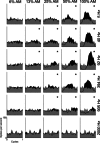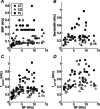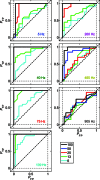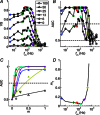Neurometric amplitude-modulation detection threshold in the guinea-pig ventral cochlear nucleus
- PMID: 23629508
- PMCID: PMC3717235
- DOI: 10.1113/jphysiol.2013.253062
Neurometric amplitude-modulation detection threshold in the guinea-pig ventral cochlear nucleus
Abstract
Amplitude modulation (AM) is a pervasive feature of natural sounds. Neural detection and processing of modulation cues is behaviourally important across species. Although most ecologically relevant sounds are not fully modulated, physiological studies have usually concentrated on fully modulated (100% modulation depth) signals. Psychoacoustic experiments mainly operate at low modulation depths, around detection threshold (∼5% AM). We presented sinusoidal amplitude-modulated tones, systematically varying modulation depth between zero and 100%, at a range of modulation frequencies, to anaesthetised guinea-pigs while recording spikes from neurons in the ventral cochlear nucleus (VCN). The cochlear nucleus is the site of the first synapse in the central auditory system. At this locus significant signal processing occurs with respect to representation of AM signals. Spike trains were analysed in terms of the vector strength of spike synchrony to the amplitude envelope. Neurons showed either low-pass or band-pass temporal modulation transfer functions, with the proportion of band-pass responses increasing with increasing sound level. The proportion of units showing a band-pass response varies with unit type: sustained chopper (CS) > transient chopper (CT) > primary-like (PL). Spike synchrony increased with increasing modulation depth. At the lowest modulation depth (6%), significant spike synchrony was only observed near to the unit's best modulation frequency for all unit types tested. Modulation tuning therefore became sharper with decreasing modulation depth. AM detection threshold was calculated for each individual unit as a function of modulation frequency. Chopper units have significantly better AM detection thresholds than do primary-like units. AM detection threshold is significantly worse at 40 dB vs. 10 dB above pure-tone spike rate threshold. Mean modulation detection thresholds for sounds 10 dB above pure-tone spike rate threshold at best modulation frequency are (95% CI) 11.6% (10.0-13.1) for PL units, 9.8% (8.2-11.5) for CT units, and 10.8% (8.4-13.2) for CS units. The most sensitive guinea-pig VCN single unit AM detection thresholds are similar to human psychophysical performance (∼3% AM), while the mean neurometric thresholds approach whole animal behavioural performance (∼10% AM).
Figures










Similar articles
-
Temporal and mean rate discharge patterns of single units in the dorsal cochlear nucleus of the anesthetized guinea pig.J Neurophysiol. 1996 Sep;76(3):1667-88. doi: 10.1152/jn.1996.76.3.1667. J Neurophysiol. 1996. PMID: 8890284
-
Temporal encoding and transmitting of amplitude and frequency modulations in dorsal cochlear nucleus.Hear Res. 1997 Apr;106(1-2):83-94. doi: 10.1016/s0378-5955(97)00004-x. Hear Res. 1997. PMID: 9112108
-
Responses of ventral cochlear nucleus onset and chopper units as a function of signal bandwidth.J Neurophysiol. 1996 Feb;75(2):780-94. doi: 10.1152/jn.1996.75.2.780. J Neurophysiol. 1996. PMID: 8714652
-
Processing of modulation frequency in the dorsal cochlear nucleus of the guinea pig: sinusoidal frequency-modulated tones.Hear Res. 1996 May;95(1-2):120-34. doi: 10.1016/0378-5955(96)00030-5. Hear Res. 1996. PMID: 8793514
-
Neural processing of amplitude-modulated sounds.Physiol Rev. 2004 Apr;84(2):541-77. doi: 10.1152/physrev.00029.2003. Physiol Rev. 2004. PMID: 15044682 Review.
Cited by
-
Perfidious synaptic transmission in the guinea-pig auditory brainstem.PLoS One. 2018 Oct 4;13(10):e0203712. doi: 10.1371/journal.pone.0203712. eCollection 2018. PLoS One. 2018. PMID: 30286113 Free PMC article.
-
Neural correlates of behavioral amplitude modulation sensitivity in the budgerigar midbrain.J Neurophysiol. 2016 Apr;115(4):1905-16. doi: 10.1152/jn.01003.2015. Epub 2016 Feb 3. J Neurophysiol. 2016. PMID: 26843608 Free PMC article.
-
Age-group differences in speech identification despite matched audiometrically normal hearing: contributions from auditory temporal processing and cognition.Front Aging Neurosci. 2015 Jan 13;6:347. doi: 10.3389/fnagi.2014.00347. eCollection 2014. Front Aging Neurosci. 2015. PMID: 25628563 Free PMC article.
-
Midbrain Synchrony to Envelope Structure Supports Behavioral Sensitivity to Single-Formant Vowel-Like Sounds in Noise.J Assoc Res Otolaryngol. 2017 Feb;18(1):165-181. doi: 10.1007/s10162-016-0594-4. Epub 2016 Oct 20. J Assoc Res Otolaryngol. 2017. PMID: 27766433 Free PMC article.
-
Olivocochlear projections contribute to superior intensity coding in cochlear nucleus small cells.J Physiol. 2022 Jan;600(1):61-73. doi: 10.1113/JP282262. Epub 2021 Dec 6. J Physiol. 2022. PMID: 34761815 Free PMC article.
References
-
- Blackburn CC, Sachs MB. Classification of unit types in the anteroventral cochlear nucleus: PST histograms and regularity analysis. J Neurophysiol. 1989;62:1303–1329. - PubMed
-
- Borina F, Firzlaff U, Schuller G, Wiegrebe L. Representation of echo roughness and its relationship to amplitude-modulation processing in the bat auditory midbrain. Eur J Neurosci. 2008;27:2724–2732. - PubMed
-
- Bregman AS. Auditory Scene Analysis. Cambridge, MA, USA: MIT Press; 1990.
-
- Burns EM, Viemeister N. Nonspectral pitch. J Acoust Soc Am. 1976;60:863–869.
Publication types
MeSH terms
Grants and funding
LinkOut - more resources
Full Text Sources
Other Literature Sources
Miscellaneous

